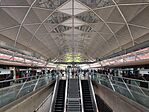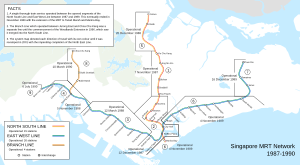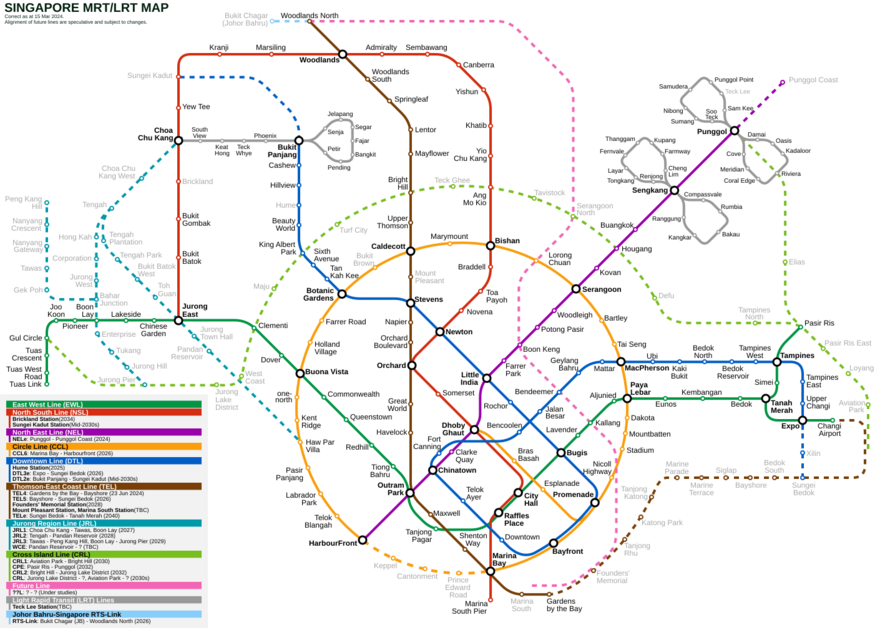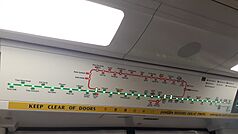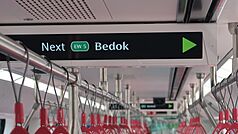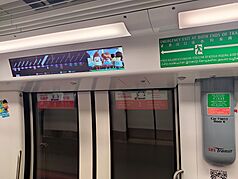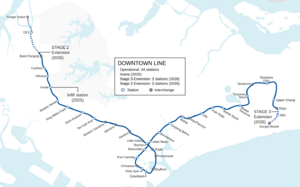Mass Rapid Transit (Singapore) facts for kids
Quick facts for kids Mass Rapid Transit (MRT) |
|||
|---|---|---|---|
 From top, left to right: Entrances of the Toa Payoh, Little India stations; Exterior of Jurong East station; East–West Line (EWL) platforms at Expo station and Thomson–East Coast Line platforms at Caldecott station
|
|||
| Info | |||
| Owner | Land Transport Authority | ||
| Locale | Singapore | ||
| Transit type | Rapid transit | ||
| Number of lines | 8 | ||
| Number of stations | 143 | ||
| Daily ridership | 3.4 million (2024) | ||
| Website |
|
||
| Operation | |||
| Began operation | 7 November 1987 | ||
| Operator(s) | SMRT Trains SBS Transit |
||
| Number of vehicles | ~623 trains comprising >2,800 carriages | ||
| Train length | 3–8 carriages | ||
| Headway | Peak: 1–3 minutes Off-peak: 5–7 minutes |
||
| Technical | |||
| System length | 242.6 km (150.7 mi) | ||
| Track gauge | 1,435 mm (4 ft 8 1⁄2 in) standard gauge | ||
| Minimum radius of curvature | 400–500 m (1,312.34–1,640.42 ft) (mainline), 190 m (623.36 ft) (depot) |
||
| Electrification | 750 V DC third rail 1,500 V DC overhead catenary |
||
| Top speed | 78–90 km/h (48–56 mph) (service) 90–100 km/h (56–62 mph) (design) |
||
|
|||
The Mass Rapid Transit system, known as MRT, is Singapore's main railway system. It helps millions of people travel across the island every day. The first part of the MRT opened in November 1987 with five stations. Since then, it has grown a lot.
Today, the MRT network covers about 242.6 km (150.7 mi) of tracks. It has 143 stations and six lines. Two more lines and 44 stations are being built. By 2040, the network is planned to be about 460 km (290 mi) long. The MRT connects with the Light Rail Transit (LRT) system. The LRT helps people get from MRT stations to their homes in nearby towns.
The MRT is the oldest and busiest metro system in Southeast Asia. It is managed by the Land Transport Authority (LTA), which builds the lines. Companies like SMRT Trains and SBS Transit operate the trains. The MRT is fully automated, meaning trains can run without drivers. All stations have platform screen doors, Wi-Fi, lifts, and air conditioning. Many older parts of the MRT are above ground, but newer lines are mostly underground. Some underground stations are also designed to be air raid shelters for safety.
History of the MRT System
How the MRT Started
The idea for the MRT began in 1967. Planners in Singapore thought a rail system would be needed by 1992. Studies were done in the 1970s to figure out how to build it.
Some government leaders worried about the high cost. They wondered if a bus-only system would be cheaper. But the Communications Minister, Ong Teng Cheong, believed that buses alone would not be enough for Singapore's small land area. He worked hard to make the MRT happen.
Important decisions were made for the MRT's design:
- Trains would use a "third rail" for power, like many other metro systems.
- Platform screen doors would be installed at stations for safety and to help with air conditioning.
Building the First Lines
The MRT was built in stages. The North–South Line was built first because it went through the city center. The Mass Rapid Transit Corporation (MRTC) was set up in 1983 to manage the project.
On November 7, 1987, the first part of the North–South Line opened. It had five stations and was 6 km (3.7 mi) long. More stations were added quickly. By the end of 1990, the first system was finished, two years ahead of schedule!
Growing the Network
The MRT has kept growing since then. In 1996, the North–South Line was extended to Woodlands. This connected more areas to the network. The LRT system was also introduced to link people from MRT stations to their homes. The first LRT line, Bukit Panjang LRT, opened in 1999.
New stations have been added to existing lines. Dover station opened in 2001, and Canberra station opened in 2019. Hume station, the first underground infill station, opened in February 2025.

The North East Line opened in 2003. It was one of the first fully automated heavy rail lines in the world. Other lines like the Circle Line and Downtown Line opened in stages over the years. The Thomson–East Coast Line also opened in stages, with its latest extension to Bayshore opening in June 2024.
MRT Network and Stations
The MRT system has several lines, each with its own name and color. These names help people easily understand where the lines go.
| Name and colour | Started | Last extension | Next extension | Ends at | Length | Stations | Depot(s) | Operator | Control Centre | Cost |
|---|---|---|---|---|---|---|---|---|---|---|
| North–South Line | 7 November 1987 | 2 November 2019 | 2034 | Jurong East Marina South Pier |
44 km (27 mi) | 27 | Bishan Depot, Ulu Pandan Depot, Changi Depot, Tuas Depot |
SMRT Trains | Kim Chuan Depot | >S$13.68 billion |
| East–West Line | 12 December 1987 | 18 June 2017 | N/A | Pasir Ris Changi Airport Tuas Link |
56.5 km (35.1 mi) | 35 | ||||
| North East Line | 20 June 2003 | 10 December 2024 | N/A | HarbourFront Punggol Coast |
21.6 km (13.4 mi) | 17 | Sengkang Depot | SBS Transit | Sengkang Depot | S$4.72 billion |
| Circle Line | 28 May 2009 | 14 January 2012 | 2026 | Dhoby Ghaut HarbourFront Marina Bay |
35.7 km (22.2 mi) | 30 | Kim Chuan Depot | SMRT Trains | Kim Chuan Depot | >S$10.81 billion |
| Downtown Line | 22 December 2013 | 28 February 2025 | 2026 | Bukit Panjang Expo |
41.9 km (26.0 mi) | 35 | Tai Seng Facility Building, Gali Batu Depot |
SBS Transit | Gali Batu Depot | S$20.7 billion |
| Thomson–East Coast Line | 31 January 2020 | 23 June 2024 | Woodlands North Bayshore |
43 km (27 mi) | 27 | Mandai Depot | SMRT Trains | Mandai Depot | S$28 billion | |
| Total: | 242.6 km (150.7 mi) | 164 | ||||||||
Station Features and Services
Most MRT stations are either elevated (above ground) or underground. All underground stations are built deep and strong enough to be used as bomb shelters. You can use your mobile phone, 3G, 4G, and 5G services throughout the entire network. Underground stations and trains have air conditioning. Above-ground stations have ceiling fans to keep cool.
Every station has machines to top up your travel cards and a Passenger Service Centre for help. They also have screens that show train information. Restrooms and payphones are available at all stations. Larger stations might have shops, supermarkets, ATMs, and other services. Escalators in stations move faster than usual to help people get around quickly.
Older stations built before 2001 did not have features like lifts or ramps for people with disabilities. But a program finished in 2006 made sure every station had at least one easy-access route. Newer stations now have at least two lifts.
Safety Measures
Safety is very important on the MRT. You will see posters and hear announcements reminding passengers about safety. Underground stations have had full-height platform screen doors since 1987. These doors keep people safe from the tracks.
For elevated stations, half-height platform screen doors were added later. They were fully installed by March 2012. These doors help prevent accidents and stop people from going onto the tracks.
There have been a few notable incidents. In 1993, two trains had a minor collision at Clementi station due to an oil spill, causing some injuries. In 2004, a tunnel under Nicoll Highway collapsed during construction, sadly leading to the loss of four workers' lives. In 2017, two trains had a low-speed collision at Joo Koon station because of a system issue. In September 2024, a train fault near Clementi station caused damage to the tracks, leading to a six-day disruption on part of the East-West Line.
After the COVID-19 pandemic started, the MRT system put in place social distancing rules and made masks mandatory. These rules helped keep commuters safe. Now, these rules are no longer required by law.
Operating Hours
MRT trains usually run from 5:30 AM to 1:00 AM every day. On special occasions like New Year's Eve, the trains might run later into the night. Sometimes, parts of the line might close earlier or open later on weekends for maintenance work.
During peak hours, trains come every 1 to 3 minutes. During off-peak hours, they come every 5 to 7 minutes.
Station Design and Art

When the MRT first started, stations were built for function, not looks. But later, station design became more important. For example, Expo station has a cool, futuristic design with a large, curved roof. Changi Airport station has a very wide platform and a bright, open feel.

Many MRT stations now feature special artworks. This program is called "Art in Transit." It includes over 300 art pieces in 80 stations. Each artwork is designed to fit the station's unique identity. For example, Bras Basah station has water features that let sunlight into the station.
Trains and Technology
Train Types
The MRT uses different types of trains, called "rolling stock." These trains are designed to be efficient and comfortable for passengers.
Signalling System
The MRT uses a special system called CBTC (Moving Block) to keep trains safe and running smoothly. This system helps trains know where other trains are, so they can keep a safe distance. It also helps control train speed and makes sure doors open and close correctly at stations.
The older North–South and East–West lines used an older system. But they were upgraded to the modern CBTC system in 2017 and 2018. Now, all MRT lines use this advanced system. CBTC allows trains to run closer together, which means more trains can run on the tracks, increasing how many people can travel. It also allows trains to run without drivers, with operations monitored from a control center.
Train Depots
Trains are stored and maintained at special places called depots. SMRT Corporation has six depots, including Bishan Depot and Changi Depot. SBS Transit has three depots, like Sengkang Depot.
A new "four-in-one" depot is being built at Tanah Merah. It will be the first in the world to house trains for three MRT lines and buses all in one place. This helps save a lot of land. There are also plans for new depots for future lines, like the Jurong Region Line and Cross Island Line.
Future Plans for the MRT
The MRT system is always growing! Singapore plans to keep expanding the network to make it even easier for people to travel.
| Line | Stage | Between | Opening | No. of stations |
Length (km) |
Depot | Operator | |||||
|---|---|---|---|---|---|---|---|---|---|---|---|---|
| New lines | ||||||||||||
| Thomson–East Coast Line | 5 | Bedok South | Sungei Bedok | 2026 | 2 | 2.5 | Mandai East Coast |
SMRT Trains | ||||
| Jurong Region Line | 1 | Choa Chu Kang | Boon Lay | Tawas | 2027 | 10 | 24 | Tengah | Singapore One Rail (ComfortDelGro's SBS Transit and RATP Dev Asia Pacific) | |||
| 2 | Tengah Plantation | Pandan Reservoir | 2028 | 7 | ||||||||
| 3 | Enterprise | Jurong Pier | 2029 | 4 | ||||||||
| Nanyang Gateway | Peng Kang Hill | 3 | ||||||||||
| Cross Island Line | 1 | Aviation Park | Bright Hill | 2030 | 12 | 29 | Changi East | rowspan=2 TBA | ||||
| 2 | Turf City | Jurong Lake District | 2032 | 6 | 15 | |||||||
| Extensions/Single stations | ||||||||||||
| North–South Line | Infill | Brickland | 2034 | 1 | N/A | Bishan Ulu Pandan |
SMRT Trains | |||||
| Sungei Kadut | 2035 | |||||||||||
| Circle Line | 6 | Keppel | Prince Edward Road | 2026 | 3 | 4 | Kim Chuan | SMRT Trains | ||||
| Downtown Line | 2e | DE1 | Sungei Kadut | 2035 | 2 | Gali Batu East Coast |
SBS Transit | |||||
| 3e | Xilin | Sungei Bedok | 2026 | 2.2 | ||||||||
| Thomson–East Coast Line | Infill | Founders' Memorial | 2028 | 1 | N/A | Mandai East Coast |
SMRT Trains | |||||
| Unopened | Mount Pleasant | rowspan=2 TBA | ||||||||||
| Marina South | ||||||||||||
| Extension | Sungei Bedok | Tanah Merah | ~2040 | colspan=2 TBA | ||||||||
| Jurong Region Line | Pandan Reservoir | West Coast | Late 2030s | colspan=2 TBA | Tengah | Singapore One Rail (ComfortDelGro's SBS Transit and RATP Dev Asia Pacific) | ||||||
| West Coast | Kent Ridge | Early 2040s | colspan=2 TBA | |||||||||
| Cross Island Line | Elias | Punggol | 2032 | 3 | 7.3 | Changi East | rowspan=2 TBA | |||||
| Aviation Park | CR1 | ~2040 | 1 | TBA | ||||||||
The government has big plans to expand the MRT system. They want to make it even bigger and better by 2040.
Downtown Line Extensions
An extension of the Downtown Line from Expo to Sungei Bedok is planned to open in 2026. This will add two more stations. Another extension from Bukit Panjang to Sungei Kadut is planned for 2035.
Thomson–East Coast Line Extensions
The final stage of the Thomson–East Coast Line, from Bedok South to Sungei Bedok, is expected to open in 2026.
A new station called Founders' Memorial is planned to open in 2028. There are also plans to extend this line to Changi Airport by around 2040. This will make it easier to get to the airport from many parts of the city.
Circle Line Stage 6
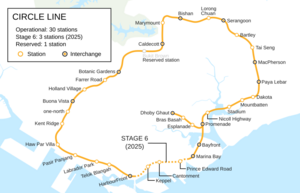
The Circle Line will soon be a complete loop! Stage 6, which includes three new stations, is set to open in the first half of 2026. This will connect the current ends of the line, making travel around the city even smoother.
Jurong Region Line
The Jurong Region Line is a new line that will serve the western parts of Singapore. It is planned to open in stages from 2027 to 2029. There are also plans to extend this line to connect with the Circle Line in the future.
Cross Island Line
The Cross Island Line will be a very long line, stretching across Singapore. It will connect many different areas and help reduce travel times. The first stage is planned to open in 2030, and more stages will open later.
New Stations on North–South Line
Two new stations, Brickland and Sungei Kadut, are planned for the existing North–South Line. They are expected to be ready by the mid-2030s.
Future Lines: Seletar and Tengah
Studies are being done for two possible new MRT lines: the Seletar Line and the Tengah Line. These lines would connect different parts of Singapore and make the network even more complete.
Fares and Tickets

To ride the MRT, you need a ticket or a travel card. Stations have special gates that you pass through to enter and exit. These gates read your ticket or card.
You can use different types of cards, including bank cards, mobile wallets, and special travel cards like EZ-Link and NETS FlashPay. You can top up your cards at machines in the station or through mobile apps.

The cost of your ride depends on how far you travel. The fares are set to be similar to bus fares, making public transport affordable. If you transfer between different MRT lines, you usually only pay one fare for your whole journey.
Tourists can buy a Singapore Tourist Pass for unlimited travel on the MRT, LRT, and buses.
MRT Performance and Improvements
The MRT system has generally been very reliable. However, there were some challenges between 2011 and 2018. These were often due to the system getting older and more people using it.
After some disruptions, the government and operators worked hard to improve the system. They invested a lot in maintenance and upgrades. These efforts have paid off, and the MRT system is now much more reliable. For example, the North–South Line saw a big improvement in how far trains could travel without delays.
Security on the MRT
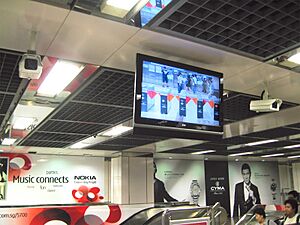
Keeping everyone safe on the MRT is a top priority. After some global incidents, security was increased. Now, there are special police officers called Public Transport Security Command (TRANSCOM) who patrol stations and trains. They are trained to handle different situations and keep an eye out for anything suspicious.
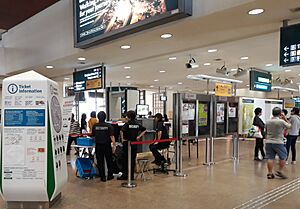
You'll hear announcements reminding passengers to report anything unusual and to keep their belongings with them. Security cameras are everywhere in stations and trains. Trash bins were moved away from platforms to reduce risks.
Regular practice drills are held to make sure everyone knows what to do in an emergency. These drills involve different government agencies working together.
There have been a couple of incidents where people broke into train depots. After these, security at the depots was made even stronger.
Rules and Etiquette
There are rules to follow when using the MRT to ensure everyone has a good experience.
- It is against the rules to smoke, eat, or drink in stations and trains. This includes sweets and plain water.
- You should not misuse emergency equipment.
- Taking photos or videos of railway assets without permission is not allowed.
- Do not go onto the tracks or into train depots.
Priority Seats
In each MRT train, there are special seats called 'priority seats'. These seats are meant for people who need them more, like the elderly, pregnant women, parents with young children, and those with mobility issues.
If you have a health condition that isn't obvious, you can get a special lanyard or sticker. This helps others know you might need a seat, even if you look fine.
See also
 In Spanish: Metro de Singapur para niños
In Spanish: Metro de Singapur para niños
- List of Singapore MRT stations
- Light Rail Transit (Singapore)
- Transport in Singapore
- List of metro systems
- Medium-capacity rail transport system
- Rail transport in Singapore





